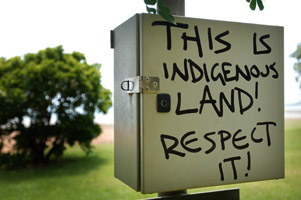A.bc
In Australia, sulle tracce di Chatwin 20 anni dopo Le Vie dei Canti
Palazzo delle Esposizioni, Roma
A.bc
In Australia, in Chatwin's footsteps 20 years after The Songlines Palazzo
Delle Esposizioni, Rome

Lui è l’ultimo erede del Gatto Selvatico e dell’Uccello
dello Spinifex. Custode del loro Sogno, del mito fondatore della storia
della sua gente, i Malbunka. «Prima dell’arrivo dei bianchi,
in Australia nessuno era senza terra, poiché tutti, uomini e donne,
ereditavano in proprietà esclusiva un pezzo del canto dell’Antenato,
e la striscia di terra su cui esso passava», scrive Bruce Chatwin
in Le vie dei canti. Herman, 70 anni, vive con moglie, figli e nipoti
a Ipolera, una minuscola comunità aborigena nel gran piatto del
Red Centre. Cinque case, un serbatoio d’acqua, due pannelli solari.
Un lungo sentiero nella collina di arenaria termina con una piccola terrazza
affacciata sulla piana desertica. «Guarda laggiù»,
dice. Tra i radi alberi e gli arbusti, dei sassi colorati appoggiati sulla
terra formano un grande disegno. «È una mappa scritta nella
nostra lingua, sono le terre della mia gente». Un tempo, spiega,
erano molto più estese di quelle che gli sono state riconosciute.
Si spingevano per centinaia e centinaia di chilometri, a sud fino al King’s
Canyon, a ovest alle McDonnell Ranges, a est alle James Ranges e a nord
a Hermannsburg. 180 chilometri da Alice Springs, Hermannsburg era la sede
di una missione luterana dove viveva Carl Strehlow, autore della ricerca
sulla cultura aborigena che ispirò Chatwin. «Mio nonno lo
conosceva; una volta, per Strehlow malato, andò a piedi fino ad
Alice Springs a cercare un dottore». Nella mappa c’è
anche Tnorala, nome aborigeno di Gosse Bluff, un cratere dal diametro
di 5 chilometri creato 142 milioni di anni fa dall’impatto di una
cometa. Secondo la leggenda, mentre un gruppo di donne danzava nella Via
Lattea una di loro posò il suo bambino nella culla che rovesciandosi
cadde sulla terra e si trasformò in una muraglia circolare di roccia.
«In inverno», racconta Herman, «quando il cielo è
pulito, puoi vedere la stella del mattino, la madre, e la stella della
sera, il padre, che cercano ancora il loro bambino»
Darwin, sulla spiaggia vicina al porto
Darwin, sulla spiaggia vicina al porto
He
is the last heir of the Wild Cat and the Spinifex Pigeon, the Guardian
of their Dream, of the founding myth of the history of their people, the
Malbunka. «Before the whites came, he went on, no one in Australia
was landless, since everyone inherited, as his or her private property,
a stretch of the Ancestor’s song and the stretch of country over
which the song passed». Bruce Chatwin wrote in The songlines. Herman,
70, lives with his wife, children and grandchildren at Ipolera, a tiny
Aboriginal community on the big flat surface of the Red Centre. Five houses,
a water tank, two solar panels. A long path in the sandstone hill ends
in a small terrace overlooking the desert plain. “Look over there”,
he says. Among the sparse trees and shrubs, some coloured stones form
a big pattern on the ground. “It’s a map written in our language,
those are our people’s lands”. They used to be much wider
than what the government has granted. They extended for hundreds and hundreds
of kilometres, south to King’s Canion, west to the McDonnel Ranges,
east to the James Ranges and north to Hermannsburg. 180 kilometres from
Alice Springs, Hermannsburg was the seat of a Lutheran Mission where Carl
Strehlow, the author of the research on the Aboriginal culture which inspired
Chatwin, lived. “My grandfather knew him; once, as Strehlow was
ill, he walked as far as Alice Spring to look for a doctor”. Tnorala,
the Aboriginal name for Gosse Bluff,is also on the map. It's a crater
5 kilometres wide, created by the impact of a comet 142 million years
ago. According to the legend, while a group of women where dancing on
the Milky Way, one of them laid her baby in the cradle which overturned
and fell on the earth turning into a circular rocky wall. “In winter”says
Hermann, “when the sky is clear, you can see the morning star, the
mother, and the evening star, the father, still looking for their baby”
Darwin, on the beach near the port
Darwin, on the beach near the port

